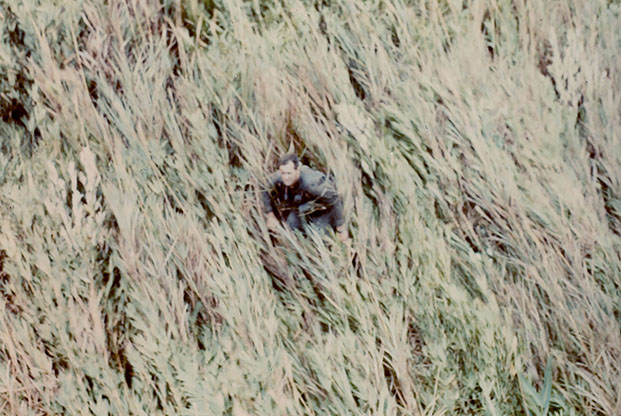
A downed USAF F-105 pilot awaits rescue in tall elephant grass in Southeast Asia in this 1972 Vietnam War photo. Photo: USAF via National Museum of the US Air Force
The world’s first combat rescue by a helicopter took place in northern Burma in April 1944. A light L-1 liaison airplane, flown by an American pilot with three wounded British soldiers aboard, had crashed behind enemy lines. There was a clearing in the jungle, but it was too small for conventional aircraft to land.
Fortunately, a YR-4 helicopter—one of only 30 then owned by the entire US Army Air Forces—was available. Lt. Carter Harman set it down in the clearing and took the survivors to an improvised landing strip on a sandbar in a river nearby, where other liaison aircraft picked them up.
It was a preview of the future of combat search and rescue, particularly of operations in the Vietnam War 20 years later, when Air Force rescue crews saved almost 4,000 airmen, soldiers, and sailors from captivity or worse.
Prior to World War II, there had been no requirement for large-scale aircrew rescue. “In World War II, an aircrew member downed behind enemy lines was virtually certain of capture or death,” said historian Earl H. Tilford Jr.
Much of the flying was over water, and rescue capability was organized primarily for recovery at sea. The mainstay of the program was the high-wing PBY Catalina flying boat. Airmen were also picked up by ships and used plywood boats dropped to them by B-17 bombers. By March 1945, 1,972 American fliers had been saved in the North Sea, the English Channel, and adjacent waters.
The R-4, forerunner of the YR-4 flown by Harman in Burma, was the first production helicopter, a new kind of flying machine developed by Igor Sikorsky. The first models for service with the AAF were delivered in December 1942. They showed enough promise that the Army ordered more of them, but they were not used extensively in World War II.
Postwar, the search and rescue mission and helicopters were assigned to Air Rescue Service, established under Air Transport Command in 1946 and moved to the Military Air Transport Service when it was created in 1948.
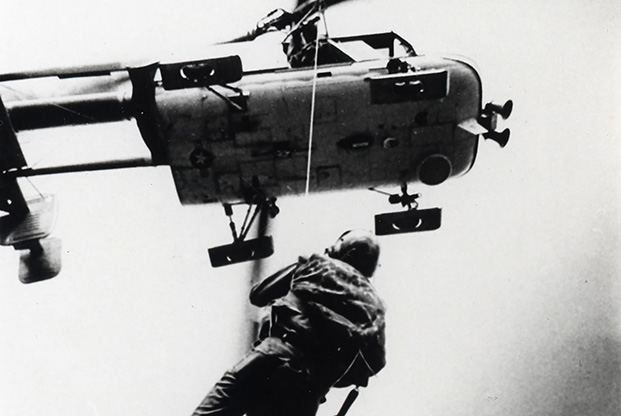
An HH-43F “Pedro” crew hoists a downed airman to safety in Southeast Asia. Photo: USAF
KOREA
All of the services had helicopters in the Korean War. The best known of them today is the Bell H-13, featured in the television series “M*A*S*H” transporting wounded soldiers from the battlefield to mobile Army surgical hospitals.
Elements of the USAF 3rd Air Rescue Squadron in Japan arrived in Korea with H-5 helicopters in July 1950. Older readers may recall the H-5 as the helicopter in which Mickey Rooney attempted to recover Navy pilot William Holden from a rice paddy in the movie “The Bridges at Toko-ri.”
Rescuing downed airmen was the top priority for Air Force helicopter crews in Korea, but their H-5s and the follow-on Sikorsky H-19s performed seven times more medical evacuations than aircrew rescues. The H-19s began arriving in 1952 and eventually replaced the H-5s, which were phased out of the inventory in 1955.
Army helicopters did most of the battlefield medical evacuations, but Air Rescue Service handled about 30 percent of them. During the three-year run of the war, 1,690 Air Force crew members went down inside enemy territory.
The Air Rescue Service saved 102 of them with helicopters, 66 with SA-16 amphibious aircraft, and two by small liaison planes. In addition, ARS extracted 84 airmen from other services and allied air forces from behind enemy lines.
The rescue force from Korea was not suited for the conflict that followed in the jungles of Southeast Asia. In any case, the Air Rescue Service lost most of its helicopters in the budget cutbacks of the 1950s. By the early 1960s, the Air Force rescue capability consisted mainly of the Kaman HH-43 Huskie, a utility helicopter used mainly for emergency fire suppression on the runway and bringing in airmen who bailed out in the vicinity of the base.
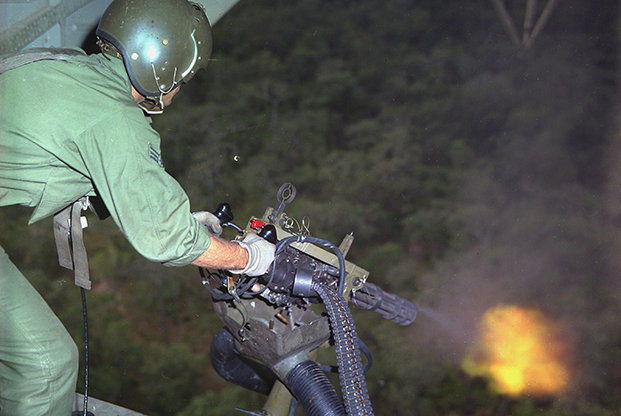
An HH-3 crewman fires a minigun during a rescue patrol over South Vietnam in 1972. Photo: USAF
PEDRO AND THE PJS
The HH-43s deployed to bases in South Vietnam and Thailand in late 1964. For the next two years, they were the only Air Force rescue helicopters in Southeast Asia. The first combat rescue was March 2, 1965, when a forward-deployed HH-43 picked up an F-105 pilot shot down near the Demilitarized Zone on the first day of Rolling Thunder, the air war against North Vietnam.
The rescue variant of the Huskie, the HH-43F, was known as “Pedro” from its radio call sign. It was a small helicopter, just 47 feet from end to end, with no armor or weapons. Nevertheless, in the final accounting, Pedro was credited with more combat saves than any other helicopter in the Vietnam War.
Pedro was superseded by the larger and more capable HH-3s and HH-53s in the rescue role but remained in service in Southeast Asia until 1975, making the HH-43 not only the first search and rescue helicopter in the theater, but also the last.
The standard rescue device was the “jungle penetrator,” lowered to the ground on a cable from the helicopter. It had spring-loaded arms to part the foliage and to provide a seat for the airman coming up or for the “PJ” pararescue jumper going down to get him.
When configured for jungle rescue, Pedro carried two pilots, a crew chief, and a PJ, plus the penetrator, a litter, a stretcher, and medical kits. The terms PJ and “pararescue jumper” were said to be derived by working backward from letter codes on an aircrew flight log, with “P” for parachutist and “J” for diver.
The PJs were medical technicians as well as survival specialists. They descended into jungles and swamps to stabilize the injured and bring out the survivors, often under fire. All of them were volunteers.
Among the most famous was A1C William A. Pitsenbarger, a PJ on one of two HH-43Fs responding to a call for help by a US Army rifle company isolated and surrounded by a Viet Cong battalion in the dense jungle east of Saigon on April 11, 1966.
Pitsenbarger rode down on the forest penetrator to help the wounded, whose numbers were mounting. The two helicopters made five flights carrying out survivors before they were forced to retreat by intense fire from the VC.
Rather than depart with them, Pitsenbarger chose to remain at the battle site, exposing himself to the enemy as he aided the injured and assisted in the defense. He was hit four times himself, the last round killing him.
Pitsenbarger was awarded the Medal of Honor posthumously.
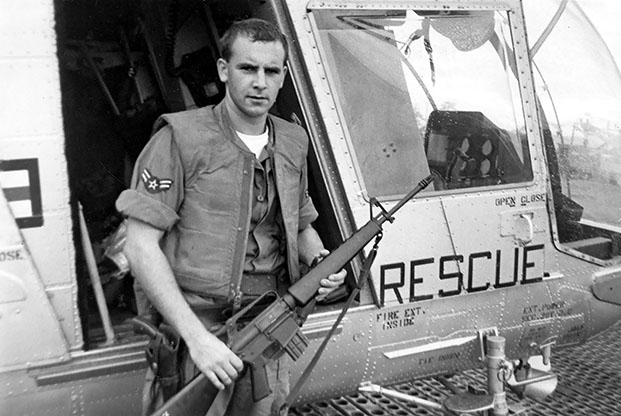
A2C William Pitsenbarger, in this circa 1965 photo, a PJ on HH-43s, was awarded the Medal of Honor for heroism in 1966. Photo: USAF
THE FIRST 45 MINUTES
Southeast Asia was a difficult operating environment, but on balance it was more of a problem for the enemy gunners than for the rescue helicopters.
“Terrain became a useful ally rather than a troublesome hindrance to combat rescue units with the proper equipment,” said historian Tilford.
The anti-aircraft guns “were limited by the same jungle that concealed them,” Tilford said. The helicopters were often screened by mountain ridges, karst outcroppings, and trees. Airmen on the ground could hide in the jungle while waiting for rescue forces to arrive. In any case, it was risky business: During the Vietnam War, 71 Air Force combat rescue crew members were killed in action, and 45 of their aircraft were lost.
The helicopters worked as part of a search-and-rescue task force, which included a control airplane and fighter escorts. The A-1 Skyraider, a single-engine, propeller-driven veteran of World War II, was a frequent companion.
It had a long loiter time, helpful in locating survivors, and substantial armament to suppress enemy ground fire. The A-1H variant, which flew with the rescue missions, was known as “Sandy” from its call sign.
One helicopter in the task force, designated as the “low bird,” went in to make the recovery, while the “high bird” stood by to assist if needed or to extract the low bird crew if they were shot down themselves.
Up to the middle of 1967, when the helicopters finally gained air-refueling capability, range and time were significant concerns. “Rescue crews sought out clearings in the jungle to use as forward operating locations, where they could stockpile fuel and await calls for help many miles and minutes closer to a downed pilot,” said the official USAF history of the war.
In almost half of the rescue efforts that failed, the critical factor was arriving too late. The chance of success was excellent if the helicopter got there within 15 minutes of the airplane crashing or being shot down. After 45 minutes, the likelihood of rescue diminished sharply, although in some instances, airmen on the ground managed to hold out and evade capture for extended periods.
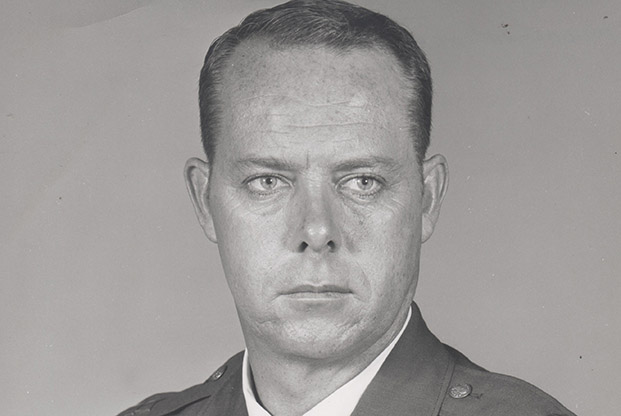
Capt. Gerald Young, Medal of Honor recipient, flew the HH-3E. Photo: USAF
BIGGER AND BETTER HELICOPTERS
The HH-3E—most famous of the rescue helicopters and called the “Jolly Green Giant” because of its green and brown camouflage—reached Southeast Asia in November 1965. Flying from Udorn in Thailand or Da Nang in South Vietnam, it could reach any point in North Vietnam.
The HH-53C, dubbed the “Super Jolly Green Giant,” got there in 1967. From the middle of 1967 on, both the HH-3 and the HH-53 had aerial refueling capability, so their range was limited only by crew endurance. Unlike Pedro, they had protective armor and they were also much faster. The HH-53 could reach speeds in excess of 190 knots in a dash.
The hefty HH-3 dwarfed the little Pedro, and the HH-53 was twice the size of the HH-3. The Super Jolly carried two PJs and up to 24 litter patients. However, the HH-53 was too large to maneuver in some valleys and other tight areas.
Pedro had gun mounts but seldom carried weapons. The Jolly Green had two 7.62 mm M-60 machine guns. The Super Jolly had three 7.62 mm gatling-type miniguns that could spit out up to 4,000 rounds per minute.
Despite the guns and armor plating, the big helicopters were still vulnerable at lower altitude. Even when traveling at top speed, the fastest of them, the HH-53, was within tracking range of various enemy guns for 30 seconds or longer. Small arms could do damage as well.
On Nov. 8, 1967, a North Vietnamese battalion ambushed a US-South Vietnamese patrol a few miles inside Laos and set up a “flak trap” for the rescue force that would be coming soon. Two helicopters—a South Vietnamese H-34 and a US Army UH-1B Huey—were shot down on arrival.
Two USAF HH-3E Jolly Green Giants came next. They retrieved several survivors but were advised to depart as the flak trap intensified. Capt. Gerald O. Young, flying the high bird, declined to go. Young’s PJ brought up two more wounded before the right engine of the helicopter exploded, hit by a rifle-launched grenade. The HH-3E flipped over on its back, burst into flames, and crashed.
Young, hanging upside down by his seat belt, managed to get out, although burns covered a fourth of his body. He used his hands to put out the fire in the clothing of an army sergeant who had been thrown clear. As the North Vietnamese closed in, Young led the enemy off into the jungle and away from the survivors. Despite drifting into shock from time to time, he eluded capture for 17 hours, and was found and rescued five miles from the crash site. A few more survivors were rescued in subsequent efforts. Young was awarded the Medal of Honor.
NUMBERS
In January 1966, Air Rescue Service was renamed Aerospace Rescue and Recovery Service under the new Military Airlift Command. The 3rd Aerospace Rescue and Recovery Group was set up at Tan Son Nhut Air Base in Saigon as the primary rescue agency for the theater.
ARRS strength in Southeast Asia peaked in the summer of 1969 with 71 rescue aircraft operating in four squadrons in South Vietnam and Thailand.
Air Force rescue crews are credited with saving 3,883 lives in Southeast Asia between 1964 and 1963. Of these, 2,807 were US military: 1,201 Air Force, 926 Army, and 680 Navy. The others were allied military members and civilians.
Almost two-thirds of these rescues took place in South Vietnam. Seven percent were in North Vietnam, and the rest were in Laos and Cambodia. They were divided about equally between aircrew and non-aircrew rescues. In the 3rd ARR Group’s tally of 2,039 combat saves between 1966 and 1970, the HH-43 Pedro accounted for 43 percent, followed by the HH-3 Jolly Green with 37 percent.
The Navy made some 225 rescues of aircrew members during the war, most of them airmen downed in the Tonkin Gulf or a few miles inland.
During the Vietnam War, the Aerospace Rescue and Recovery Service “became the greatest combat aircrew recovery force in the history of aerial warfare,” said Tilford. However, the operations had been against lightly armed forces in an area with geographic features favorable to search and recovery. It was questionable whether similar success could be expected “in the highly defended, relatively open areas of Europe” or “the flat sands of the Middle East.”
CHANGING FOCUS
When the Vietnam War ended, so did nearly all of the demand for combat search and rescue. The mission declined in importance and as a funding priority.
The effort with the highest visibility over the next decade was the “Desert One” fiasco, the aborted attempt in April 1980 to rescue American hostages in Iran.
It was conducted with Navy RH-53D Sea Stallion helicopters flown by Marine Corps aircrews. It was a special operations venture, rather than search and rescue, and no ARRS units took part.
Later that year, the best of the ARRS helicopters, the HH-53 Super Jollies, were transferred to the 1st Special Operations Wing of Tactical Air Command.
By the time the Gulf War began in 1991, considerable separation had developed between combat search and rescue and special operations.
“On the eve of Desert Storm, Air Force CSAR capability had been dramatically reduced from its peak during the war in Southeast Asia,” said historian Darrel D. Whitcomb. “Its primary recovery helicopters, the HH-53s, had been transferred to special operations. The remaining HH-3s were marginally combat-capable or survivable in a high-threat area. New HH-60s were only beginning to arrive.”
Search and rescue in the Gulf War was controlled by the joint special operations component, which was headed by an Army colonel. Some Air Force officers were dissatisfied with the level of effort. Only seven search and rescue missions were launched. Of the 64 airmen shot down, three were rescued and 19 became prisoners of war. As Whitcomb points out, most of the aircraft that were lost went down in high-threat areas under enemy control. In many instances, an attempt at rescue was not feasible.
The combat search and rescue mission was reassigned to Air Combat Command in 1993, then to Air Force Special Operations Command in 2003, and back to ACC in 2006. Currently, ACC, the Guard and Reserve, and overseas commands all fly the medium-lift HH-60G Pave Hawk, which has replaced the HH-3E Jolly Green in the rescue role.
The last of the MH-53 Pave Low helicopters—the Super Jolly variant for special operations—was retired in 2008. AFSOC now uses the CV-22B Osprey tilt-rotor aircraft for inserting and recovering special operations personnel.
THE NEXT GENERATION
Today, the Pave Hawk fleet is 30 years old and in dire need of replacement. The helicopters have been used hard and are challenging to maintain.
The Air Force planned in the early 2000s to acquire the CSAR-X, a larger and more capable helicopter that would have carried three PJs and four litter patients, compared to two PJs and two litters on Pave Hawk. In 2009, though, Secretary of Defense Robert M. Gates canceled CSAR-X, calling it “yet another single-service solution with a single-purpose aircraft.”
In 2014, Sikorsky won a contract for the HH-60W, based on the Black Hawk design and to be called Pave Hawk II. The Air Force settled for “narrowed requirements” compared with CSAR-X, but the new combat rescue helicopter will still have increased range and more cabin space than the HH-60G, as well as improved technology. The program is going well, and Sikorsky has advanced the date for projected first deliveries to March 2020.
_
John T. Correll was editor-in-chief of Air Force Magazine for 18 years and is a frequent contributor. His most recent article, “Peacekeeper by Fits and Starts,” appeared in the March issue.